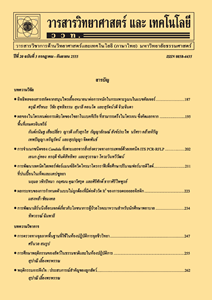การจำแนกพันธุ์และการวิเคราะห์ความสัมพันธ์ทางพันธุกรรมของกล้วยไม้สกุลกุหลาบด้วยลำดับนิวคลีโอไทด์ของตำแหน่งจำเพาะ
Main Article Content
Abstract
บทคัดย่อ
กล้วยไม้สกุลกุหลาบเป็นกล้วยไม้ที่มีความสำคัญและได้รับความนิยม เนื่องจากมีดอกสวยงามและกลิ่นหอม ปัจจุบันการจำแนกพันธุ์ตามลักษณะสัณฐานมีความยุ่งยาก ดังนั้นงานวิจัยนี้จึงได้จำแนกพันธุ์กล้วยไม้สกุลกุหลาบ 12 พันธุ์ และสกุลหนวดพราหมณ์ 1 พันธุ์ ด้วยลำดับนิวคลีโอไทด์ของตำแหน่งจำเพาะ โดยเพิ่มปริมาณชิ้นดีเอ็นเอบริเวณ ITS ยีน matK และชิ้นดีเอ็นเอที่อยู่ระหว่างยีน trnH กับ psbA ด้วยปฏิกิริยาลูกโซ่พอลิเมอเรส พบว่าบริเวณ ITS ไม่เหมาะสมที่จะนำมาใช้เนื่องจากไม่สามารถเพิ่มปริมาณชิ้นดีเอ็นเอของกล้วยไม้ได้ครบทั้ง 13 พันธุ์ เมื่อตรวจสอบลำดับนิวคลีโอไทด์และวิเคราะห์ข้อมูลด้วยโปรแกรม ClustalW2 และ MEGA 4.0 พบว่ายีน matK และชิ้นดีเอ็นเอที่อยู่ระหว่างยีน trnH กับ psbA สามารถจำแนกพันธุ์กล้วยไม้ออกจากกันได้ 11 พันธุ์ โดยไม่สามารถแยกเอื้องกุหลาบชมพูกระบี่กับเอื้องกุหลาบน่านออกจากกัน อย่างไรก็ตาม ลำดับนิวคลีโอไทด์ของยีน rpoC1 และ rpoB สามารถจำแนกเอื้องกุหลาบชมพูกระบี่กับเอื้องกุหลาบน่านออกจากกันได้
คำสำคัญ : สกุลกุหลาบ; การจำแนก; ความสัมพันธ์ทางพันธุกรรม; ยีนจำเพาะ
Abstract
Aerides is an important and most popular orchid because its flower is beautiful and fragrance. At present, identification base on morphology have been difficult. This research, the nucleotide sequences of specific sites were used to identify 12 Aerides and 1 Seidenfadenia varieties. The matK and trnH-psbA intergenic spacer were suitable to use because all DNA samples were amplified by polymerase chain reaction (PCR), while ITS was unsuitable. The PCR products of matK and trnH-psbA intergenic spacer were used to nucleotide sequencing and then the data were analyzed by ClustalW2 and MEGA 4.0. These results show that nucleotide sequences of matK and trnH-psbA intergenic spacer could distinguish 11 out of 13 orchids varieties, excepted A. krabiense and A. rosea. However, the nucleotide sequences of rpoC1 and rpoB were used to identify both of A. krabiense and A. rosea.
Keywords: Aerides; identification; genetic relationship; specific gene


